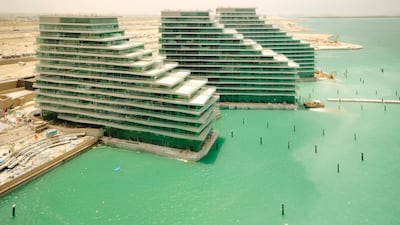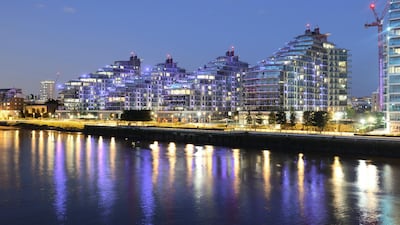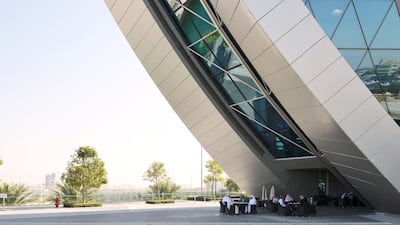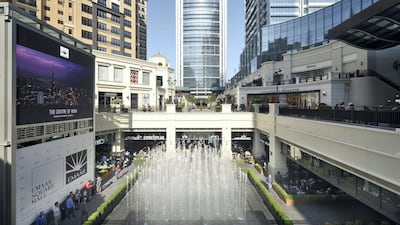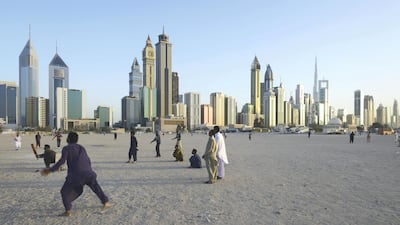Last week, as the UAE recovered from the opening of the Louvre Abu Dhabi and braced itself for Dubai Design Week's exhibitions, conferences, workshops, graduate shows, fairs, pop-up boutiques and the selfie-inducing Prologue, a sculpture that features more than 8,000 topaz-coloured Swarovski crystals, a very different type of exhibition opened in Abu Dhabi.
Little more than a series of photographs accompanied by statistics, infographics and brief texts displayed in the Project Space at New York University Abu Dhabi (NYUAD), Learning from Gulf Cities appears modest but its scope and implications could not be more profound.
“See the Gulf, See the World” proclaims a panel while setting out the show’s basic premise: that rather than being exceptional, the cities of the Arabian Gulf are actually extreme architectural laboratories and lenses through which broader international urban trends can be seen.
“Gulf cities are designed and engineered by actors near and far and then, in turn, replicated elsewhere. They are very much part of the global circulation of ideas, investments, designs, technologies, and people”, it continues.
"Rather than celebrate – or simply ridicule and deplore – we look for lessons that are relevant for other cities in the world", the text concludes, aligning Learning from Gulf Cities with the project that not only provided the show with its inspiration but also with its name.
In 1972, the architects Robert Venturi, Denise Scott-Brown and Steven Izenour produced one of the most controversial texts of 20th century architectural history, Learning from Las Vegas, an urban study that dared to consider the Las Vegas strip on its own terms and without prejudice, looking for meaning in a place considered monstrous by architects and moralists alike.
“We are a part of the same scholarly tradition,” explains the veteran academic Harvey Molotch, who founded the current project alongside Davide Ponzini, a professor of urban planning at the Politecnico di Milano.
“There was a similarly dualistic reading of Las Vegas – the spectacle of the building and the shows and the suspicion,” he says, drawing parallels between historic and contemporary attitudes to Nevada, Abu Dhabi and Dubai.
“The big thrust is to restrain yourself from the presumption that Gulf cities are the product of some diabolical plot and from the adulation of their spectacle and to pull back and to start to encourage people to look at Gulf cities in a different manner.”
Molotch, a professor of sociology and metropolitan studies at New York University, was inspired to find out more about Gulf cities following a brief teaching stint at NYUAD in 2014.
“Coming in from the outside, I became extremely curious about the mechanisms that hold this place together: politically, economically and culturally. I found the whole place puzzling, so I started trying to learn as much as I could about the region and Davide’s was one of the articles that captured my attention,” Molotch says of the colleague with whom he has since formed an “intellectual marriage”.
“There is a difficulty in interpreting so many things here because they do not match with any urban theory that we have encountered before and we both realised that we needed different intellectual tools,” Ponzini explains.
“We also wanted to reframe the work that so many Gulf scholars have been doing by saying that Gulf cities are extreme, but they are not exceptional and to try to connect what local area specialists know about Gulf cities to a more global understanding of urbanisation at large.”
It wasn't long before Molotch and Ponzini were joined by the third member of their urban trifecta, Michele Nastasi, an Italian architectural photographer who has not only been researching the region for more than a decade, but who also worked with Ponzini on the publication that alerted the academics to each other in the first place, Starchitecture: Scenes, Actors, and Spectacles in Contemporary Cities (2016).
In its particular combination of Ponzini's words with Nastasi's images, not only did Starchitecture help to set a visual and methodological precedent for Learning From Gulf Cities but it also helped to identify many of the locations, companies and individuals who now feature in the NYUAD show, which compares carefully composed images of Abu Dhabi, Dubai, Doha and Riyadh with pictures of London, New York, Barcelona, Baku and Milan.
A hugely experienced architectural photographer, Nastasi is at pains to contrast the kind of images he has made for Learning From Gulf Cities with the more usual photographs that depict architecture in the region.
“The idea of representation is crucial. Most architectural photography is paid for by the architects who have designed the buildings and with the crisis of editorial work in magazines and reviews most websites and blogs don’t have the budget to commission photographers,” the photographer says.
“They just publish whatever the architects send them and that’s a problem because the images are becoming more and more promotional, so this is an effort to separate myself from the market and the system and to develop the eye of a passer-by,” he adds.
In a series of images that contrast panoramas with street views and that record buildings in their social as well as their physical context, Nastasi not only attempts to illustrate the concepts and ideas developed by Ponzini and Molotch, but also develops a thesis about the role images can play in promoting a more critical approach to urban life.
“I wanted to try and see the architecture in its place with all of the contradictions of those places. It’s not so difficult, you just have to widen your view and concentrate on the multiplicity of elements that make up a city and to give you the sense of being there. It’s more than the building, it’s the environment, there are the people, the public space, the streets,” he says.
“We have to take care about what images are doing to us. Trying to deconstruct the rules of images and how they are used and circulated is an act of consciousness about our built environment and society.”
A photograph of Emaar Square in Istanbul is a case in point. Featuring a landmark tower designed by Foster and Partners, the development includes an Emaar Square Mall, the Address Hotel and residences and the kind of standard retail units, fountains and finishes that make it difficult to locate. A large outdoor screen dominates the square and carries an image of Downtown Dubai, which is proclaimed as “The Centre of Now”.
As well as Istanbul, the exhibition also includes other images of what Nastasi describes as a “placeless geography”.
“The idea is that there is a circulation of money, investments, ideas and designs but what I am trying to stress as a photographer, is that there is also a circulation of images and that these images also help to drive the transformation of cities,” the photographer insists.
“Sometimes you will hardly recognise where you are. This is something that is a consequence of only concentrating on images and the surface of things. If you see a skyline from afar, it is a spectacle that gives you the idea of a modern city but that is completely different from the impression you get when you enter the city and pass through the streets.”
Several micro-studies in Learning From Gulf Cities investigate the spread of these increasingly common urban features, an effective denial of unique notions of place that has been described by the architectural historian Nasser Rabbat as "Dubai Syndrome".
In Similar Forms, Different Landings, the exhibition looks at the subtle and not-so-subtle ways that architectural designs appear and reappear around the world, belying the claims to sensitivity and specificity often made by contemporary architects.
Building on research they conducted for their Starchitect project, Ponzini and Nastasi compare Atelier Jean Nouvel’s 38-storey Torre Agbar in Barcelona, whose location they approve of, with the firm’s 46-storey Burj Doha, proposing that buildings travel, but landmarks cannot.
"Meaningful buildings and places need to be designed and developed and discussed and eventually redesigned for specific places and for the communities that exist in those places. That's a meaningful way of making cities," Ponzini insists, ignoring the fact that even when a building is developed, it still has to function as a piece of architecture to be a success.
In January, the Torre Agbar was sold for the second time in three years as it continues to be the focus of disappointed tenants who have complained of "dirty windows, an awkward donut-shaped floor plan and inoperable sun blinds", just come of the gripes reported the online design publication, Dezeen.
________________
Read more:
What do a Coke can and a tennis ball have in common? Design genius
________________
Exclusive: Emirati product designer Khalid Shafar on his light and motion installation inspired by the Islamic faith
Another panel investigates three schemes by the architects Broadway Malyan, whose 2007 design for waterside apartment buildings at Al Bandar in Abu Dhabi, which was completed in 2011, then reappeared at Battersea Reach in London in 2014 at the same time as a similar scheme in Port Baku.
The UK scheme had actually been designed first but had taken 14 years to come to fruition, whereas the project in Azerbaijan, which was more than 10 times as large, took only five years from appointment to completion.
"Gulf cities act as urban 'test beds' for architectural, engineering and design experiments," a panel in the exhibition states. "Encouragement comes from 'fast-track governance', ready capital, and low-cost labour; citizen opposition does not stand in the way."
After two years of research, workshops in Abu Dhabi, New York and Milan and exhibitions at NYU and now NYUAD, the team behind Learning From Gulf Cities is now on the verge of producing a book, published by New York University Press, that will draw on the work of some of the 50 or so academics and professionals who have contributed to the project thus far.
At its best, Learning From Gulf Cities combines research into issues such as the international real estate investment and development patterns of bodies such as the Qatar Investment Authority, Emaar and DP World and illustrates how these have tangible and increasingly international urban effects.
When these are combined with Nastasi’s images, the effect can be as alarming as it is revelatory.
“The exhibition is not here to celebrate Gulf cities and it’s not here to deplore them,” says Ponzini. “We want to suspend judgement in order to come back with more refined ideas.”
Unfortunately, despite all of the attempts at objectivity and nuance, the exhibition points to a number of incredibly hard and often unpalatable lessons that design professionals and developers will most likely want to forget.
Learning From Gulf Cities runs at the Project Space at NYUAD until December 6

